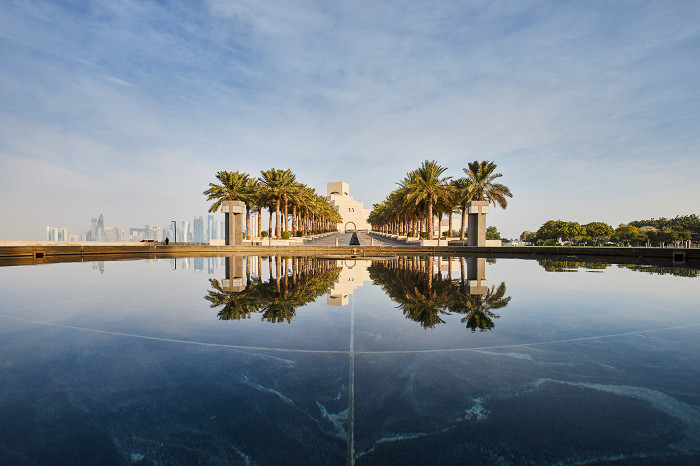The symbol of Qatar is the original Museum of Islamic Art, located in the city of Doha, an incredibly attractive cultural attraction of world importance.
The fascinating architectural appearance of the building, made in the style of Islamic architecture, is a five-story tower with “wings” of long terraces, decorated with arched windows in the Arabic style. The walls are made of white stone blocks and seem to form a pyramid, and the building itself on an artificial island on the shore of the sea bay looks more like a beautiful private villa of some sheikh than a museum.
The unique museum, which includes more than 14 centuries of Islamic art, was the first of its kind in the Arab states of the Persian Gulf. The construction of the museum was completed in 2006.
In November 2008, was held the grand opening of the museum, its project was prepared by the American architect of Chinese origin, Io Ming Pei (or Yuming Bei), winner of the Pritzker Prize, who was 91 years old at that time. One of the most famous architects of our time, he is also the author of the original glass pyramid for the Louvre in Paris, the Raffles City complex in Singapore, the Suzhou extension in China.
The modernist design of the Museum of Islamic Art organically synthesizes modern technology with the traditions of Arabic architecture. The total area of the building is 45 000 square meters.

Photo: tonkosti.ru
The three floors of the museum house exhibition halls, which have a stylish, laconic interior in white and gray tones, designed by the team of architect Jean-Michel Wilmotte.
The design uses Arabic geometric ornaments and expensive materials, but there is no excessive luxury inherent in the Arabs.
In the center of the giant atrium hall there is a huge lamp in the form of a luminous ring, covered with Arabic paintings, and the floor of the first floor is decorated with a contrasting marble rosette. Interestingly, the exhibition halls smoothly transition from one to another and passing through them, the visitor moves in a spiral, then getting on the stairs leading to the next floor. There are modern elevators decorated in Arabic style.
The territory of the magnificent structure is surrounded by a wide palm alley, fountains, pools and artificial waterfalls.
The largest collection of Islamic art of the museum includes: ancient manuscripts, jewelry, wood and metal products, daggers, handmade carpets, a collection of ancient coins, paintings by Islamic artists, ceramics and textiles, glass. Some exhibits are over 200 years old. The priceless treasures of the museum are: the richest collection of Islamic artifacts, calligraphic texts and the ancient Koran dating back to the VI century.
The collection contains over 800 manuscripts on science, literature and religious subjects; the famous Abbasid blue Quran is the rarest manuscript in the Islamic world.
Ceramic bowl - an example of fine ceramics, made in Basra (Iraq), has an inscription adorning it, which reads: “what has been done is worth it” and is an early method of Arabic calligraphy used throughout the territories of the Abbasid Caliphate (750-1258 AD).
One of the unusual exhibits - a quaint old Persian carpet occupies the whole hall. The collections exhibited in the museum are collected in different countries of the world, including (Central Asia, Egypt, Spain, Türkiye, Pakistan, Iran, Iraq, India, Syria, Bahrain, Saudi Arabia).
Interesting facts:
- The design of the exposition is original - in the darkened rooms, the rays of light highlight individual masterpieces, and the light itself pours into a giant atrium through a glass wall overlooking the sea;
- The museum consists of exhibition halls, a huge library and a research institute;
- A visit to the museum for men and women is available only at different times;
- The purpose of the museum is to present the rich diversity and versatility of the art of the Islamic world, showing masterpieces created on three continents, from the VII to the XIX centuries.
- The museum hosts thematic exhibitions all year round, collections for them are brought from the Louvre, the Metropolitan, the Cartier Foundation in Paris, the Egyptian Museum of Islamic Art and the Moroccan Royal Collection.
Resources: m.orangesmile.com; hisour.com; tonkosti.ru; google.com; yandex.ru; ru.m.wikipedia.org
Also read:

